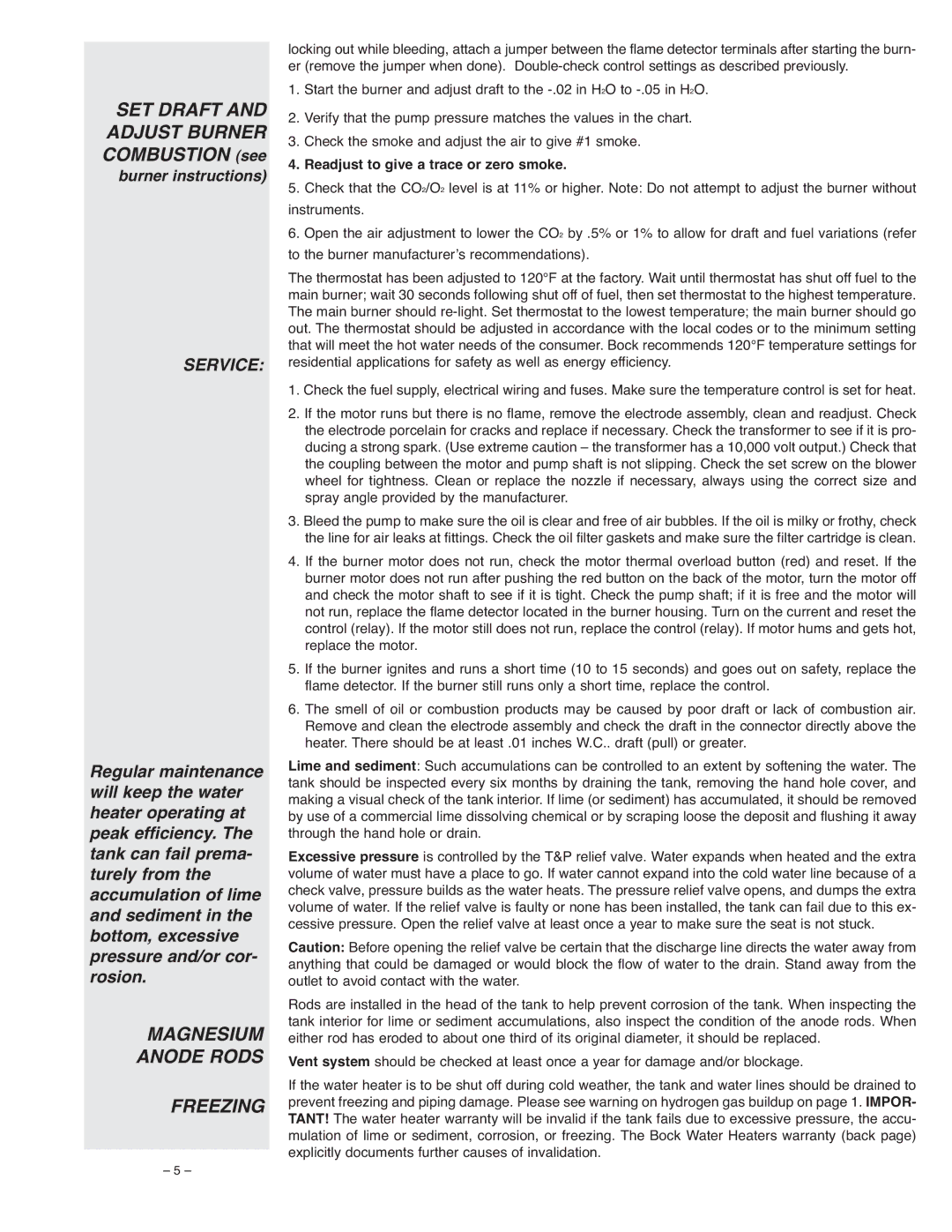locking out while bleeding, attach a jumper between the flame detector terminals after starting the burn- er (remove the jumper when done). Double-check control settings as described previously.
1. Start the burner and adjust draft to the -.02 in H2O to -.05 in H2O.
2. Verify that the pump pressure matches the values in the chart.
3. Check the smoke and adjust the air to give #1 smoke.
4. Readjust to give a trace or zero smoke.
5. Check that the CO2/O2 level is at 11% or higher. Note: Do not attempt to adjust the burner without instruments.
6. Open the air adjustment to lower the CO2 by .5% or 1% to allow for draft and fuel variations (refer to the burner manufacturer’s recommendations).
The thermostat has been adjusted to 120°F at the factory. Wait until thermostat has shut off fuel to the main burner; wait 30 seconds following shut off of fuel, then set thermostat to the highest temperature. The main burner should re-light. Set thermostat to the lowest temperature; the main burner should go out. The thermostat should be adjusted in accordance with the local codes or to the minimum setting that will meet the hot water needs of the consumer. Bock recommends 120°F temperature settings for residential applications for safety as well as energy efficiency.
1. Check the fuel supply, electrical wiring and fuses. Make sure the temperature control is set for heat.
2. If the motor runs but there is no flame, remove the electrode assembly, clean and readjust. Check the electrode porcelain for cracks and replace if necessary. Check the transformer to see if it is pro- ducing a strong spark. (Use extreme caution – the transformer has a 10,000 volt output.) Check that the coupling between the motor and pump shaft is not slipping. Check the set screw on the blower wheel for tightness. Clean or replace the nozzle if necessary, always using the correct size and spray angle provided by the manufacturer.
3. Bleed the pump to make sure the oil is clear and free of air bubbles. If the oil is milky or frothy, check the line for air leaks at fittings. Check the oil filter gaskets and make sure the filter cartridge is clean.
4. If the burner motor does not run, check the motor thermal overload button (red) and reset. If the burner motor does not run after pushing the red button on the back of the motor, turn the motor off and check the motor shaft to see if it is tight. Check the pump shaft; if it is free and the motor will not run, replace the flame detector located in the burner housing. Turn on the current and reset the control (relay). If the motor still does not run, replace the control (relay). If motor hums and gets hot, replace the motor.
5. If the burner ignites and runs a short time (10 to 15 seconds) and goes out on safety, replace the flame detector. If the burner still runs only a short time, replace the control.
6. The smell of oil or combustion products may be caused by poor draft or lack of combustion air. Remove and clean the electrode assembly and check the draft in the connector directly above the heater. There should be at least .01 inches W.C.. draft (pull) or greater.
Lime and sediment: Such accumulations can be controlled to an extent by softening the water. The tank should be inspected every six months by draining the tank, removing the hand hole cover, and making a visual check of the tank interior. If lime (or sediment) has accumulated, it should be removed by use of a commercial lime dissolving chemical or by scraping loose the deposit and flushing it away through the hand hole or drain.
Excessive pressure is controlled by the T&P relief valve. Water expands when heated and the extra volume of water must have a place to go. If water cannot expand into the cold water line because of a check valve, pressure builds as the water heats. The pressure relief valve opens, and dumps the extra volume of water. If the relief valve is faulty or none has been installed, the tank can fail due to this ex- cessive pressure. Open the relief valve at least once a year to make sure the seat is not stuck.
Caution: Before opening the relief valve be certain that the discharge line directs the water away from anything that could be damaged or would block the flow of water to the drain. Stand away from the outlet to avoid contact with the water.
Rods are installed in the head of the tank to help prevent corrosion of the tank. When inspecting the tank interior for lime or sediment accumulations, also inspect the condition of the anode rods. When either rod has eroded to about one third of its original diameter, it should be replaced.
Vent system should be checked at least once a year for damage and/or blockage.
If the water heater is to be shut off during cold weather, the tank and water lines should be drained to prevent freezing and piping damage. Please see warning on hydrogen gas buildup on page 1. IMPOR- TANT! The water heater warranty will be invalid if the tank fails due to excessive pressure, the accu- mulation of lime or sediment, corrosion, or freezing. The Bock Water Heaters warranty (back page) explicitly documents further causes of invalidation.

